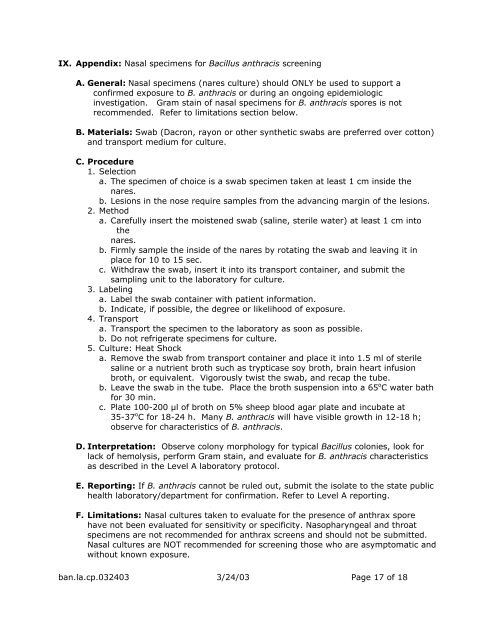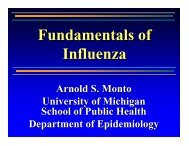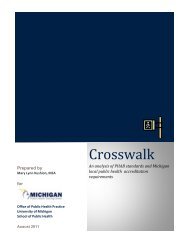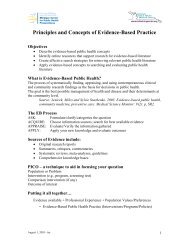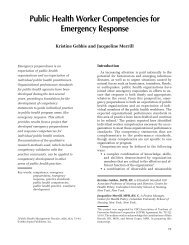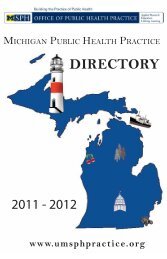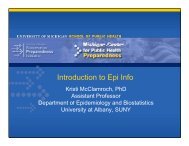Anthrax Lab Protocol - Office of Public Health Practice
Anthrax Lab Protocol - Office of Public Health Practice
Anthrax Lab Protocol - Office of Public Health Practice
Create successful ePaper yourself
Turn your PDF publications into a flip-book with our unique Google optimized e-Paper software.
IX. Appendix: Nasal specimens for Bacillus anthracis screening<br />
A. General: Nasal specimens (nares culture) should ONLY be used to support a<br />
confirmed exposure to B. anthracis or during an ongoing epidemiologic<br />
investigation. Gram stain <strong>of</strong> nasal specimens for B. anthracis spores is not<br />
recommended. Refer to limitations section below.<br />
B. Materials: Swab (Dacron, rayon or other synthetic swabs are preferred over cotton)<br />
and transport medium for culture.<br />
C. Procedure<br />
1. Selection<br />
a. The specimen <strong>of</strong> choice is a swab specimen taken at least 1 cm inside the<br />
nares.<br />
b. Lesions in the nose require samples from the advancing margin <strong>of</strong> the lesions.<br />
2. Method<br />
a. Carefully insert the moistened swab (saline, sterile water) at least 1 cm into<br />
the<br />
nares.<br />
b. Firmly sample the inside <strong>of</strong> the nares by rotating the swab and leaving it in<br />
place for 10 to 15 sec.<br />
c. Withdraw the swab, insert it into its transport container, and submit the<br />
sampling unit to the laboratory for culture.<br />
3. <strong>Lab</strong>eling<br />
a. <strong>Lab</strong>el the swab container with patient information.<br />
b. Indicate, if possible, the degree or likelihood <strong>of</strong> exposure.<br />
4. Transport<br />
a. Transport the specimen to the laboratory as soon as possible.<br />
b. Do not refrigerate specimens for culture.<br />
5. Culture: Heat Shock<br />
a. Remove the swab from transport container and place it into 1.5 ml <strong>of</strong> sterile<br />
saline or a nutrient broth such as trypticase soy broth, brain heart infusion<br />
broth, or equivalent. Vigorously twist the swab, and recap the tube.<br />
b. Leave the swab in the tube. Place the broth suspension into a 65 o C water bath<br />
for 30 min.<br />
c. Plate 100-200 µl <strong>of</strong> broth on 5% sheep blood agar plate and incubate at<br />
35-37 o C for 18-24 h. Many B. anthracis will have visible growth in 12-18 h;<br />
observe for characteristics <strong>of</strong> B. anthracis.<br />
D. Interpretation: Observe colony morphology for typical Bacillus colonies, look for<br />
lack <strong>of</strong> hemolysis, perform Gram stain, and evaluate for B. anthracis characteristics<br />
as described in the Level A laboratory protocol.<br />
E. Reporting: If B. anthracis cannot be ruled out, submit the isolate to the state public<br />
health laboratory/department for confirmation. Refer to Level A reporting.<br />
F. Limitations: Nasal cultures taken to evaluate for the presence <strong>of</strong> anthrax spore<br />
have not been evaluated for sensitivity or specificity. Nasopharyngeal and throat<br />
specimens are not recommended for anthrax screens and should not be submitted.<br />
Nasal cultures are NOT recommended for screening those who are asymptomatic and<br />
without known exposure.<br />
ban.la.cp.032403 3/24/03 Page 17 <strong>of</strong> 18


